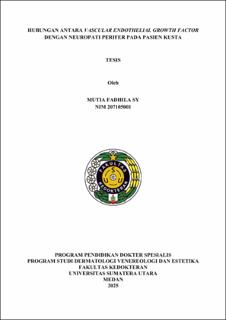| dc.contributor.advisor | Lubis, Ramona Dumasari | |
| dc.contributor.advisor | Nadeak, Kristina | |
| dc.contributor.author | Sy, Mutia Fadhila | |
| dc.date.accessioned | 2025-07-04T04:22:33Z | |
| dc.date.available | 2025-07-04T04:22:33Z | |
| dc.date.issued | 2025 | |
| dc.identifier.uri | https://repositori.usu.ac.id/handle/123456789/104890 | |
| dc.description.abstract | Background: Leprosy commonly involves the peripheral nerves, resulting in peripheral neuropathy. Neuropathy in leprosy is usually chronic and is caused by granuloma formation and inflammatory responses resulting from the pathological invasion of Schwann cells and axons by Mycobacterium leprae. Vascular endothelial growth factor (VEGF) is a signaling protein produced by various cells in response to conditions such as hypoxia. Increased VEGF activity in leprosy may also contribute to tissue damage. Excessive angiogenesis may lead to the formation of abnormal and fragile blood vessels, which can further contribute to peripheral nerve injury. VEGF is thought to play a role in the detection and prediction of nerve damage in leprosy, as well as in elucidating the pathophysiological mechanisms
underlying leprosy-induced peripheral neuropathy.
Objective: To determine the association between vascular endothelial growth factor (VEGF) serum levels and peripheral neuropathy in patients with leprosy.
Subjects and Methods: This analytic observational study employed a cross-sectional design involving 30 leprosy patients with peripheral neuropathy and 30 leprosy patients without peripheral neuropathy. Baseline data, physical examinations, dermatological assessments, and the Semmes-Weinstein monofilament test were used to identify study subjects. Blood samples were analyzed using ELISA to measure serum VEGF levels.
Results: The majority of leprosy patients with peripheral neuropathy were in the 26–35 and 36–45 years age groups, each comprising 11 subjects (36.7%). Male patients were more prevalent, accounting for 19 individuals (63.3%). The mean serum VEGF level in leprosy patients with peripheral neuropathy was 3387.76±2147.05 µg/mL, whereas in those without peripheral neuropathy it was 1142.46±203.07 µg/mL. Serum VEGF levels in the neuropathy group were almost three times higher than in the non-neuropathy group.
Conclusion: There is an association between serum VEGF levels and peripheral neuropathy in patients with leprosy.
Keywords: Leprosy, peripheral neuropathy, vascular endothelial growth factor, Semmes-Weinstein monofilament test. | en_US |
| dc.language.iso | id | en_US |
| dc.publisher | Universitas Sumatera Utara | en_US |
| dc.subject | Leprosy | en_US |
| dc.subject | Peripheral neuropathy | en_US |
| dc.subject | Vascular endothelial growth factor | en_US |
| dc.subject | Semmes-Weinstein monofilament test | en_US |
| dc.title | Hubungan antara Vascular Endothelial Growth Factor dengan Neuropati Perifer pada Pasien Kusta | en_US |
| dc.title.alternative | Relationship between Vascular Endothelial Growth Factor and Peripheral Neuropathy in Leprosy | en_US |
| dc.type | Thesis | en_US |
| dc.identifier.nim | NIM207105001 | |
| dc.identifier.nidn | NIDN0004107203 | |
| dc.identifier.kodeprodi | KODEPRODI11771#Dermatologi Venereologi dan Estetika | |
| dc.description.pages | 98 Pages | en_US |
| dc.description.type | Tesis Magister | en_US |
| dc.subject.sdgs | SDGs 4. Quality Education | en_US |


